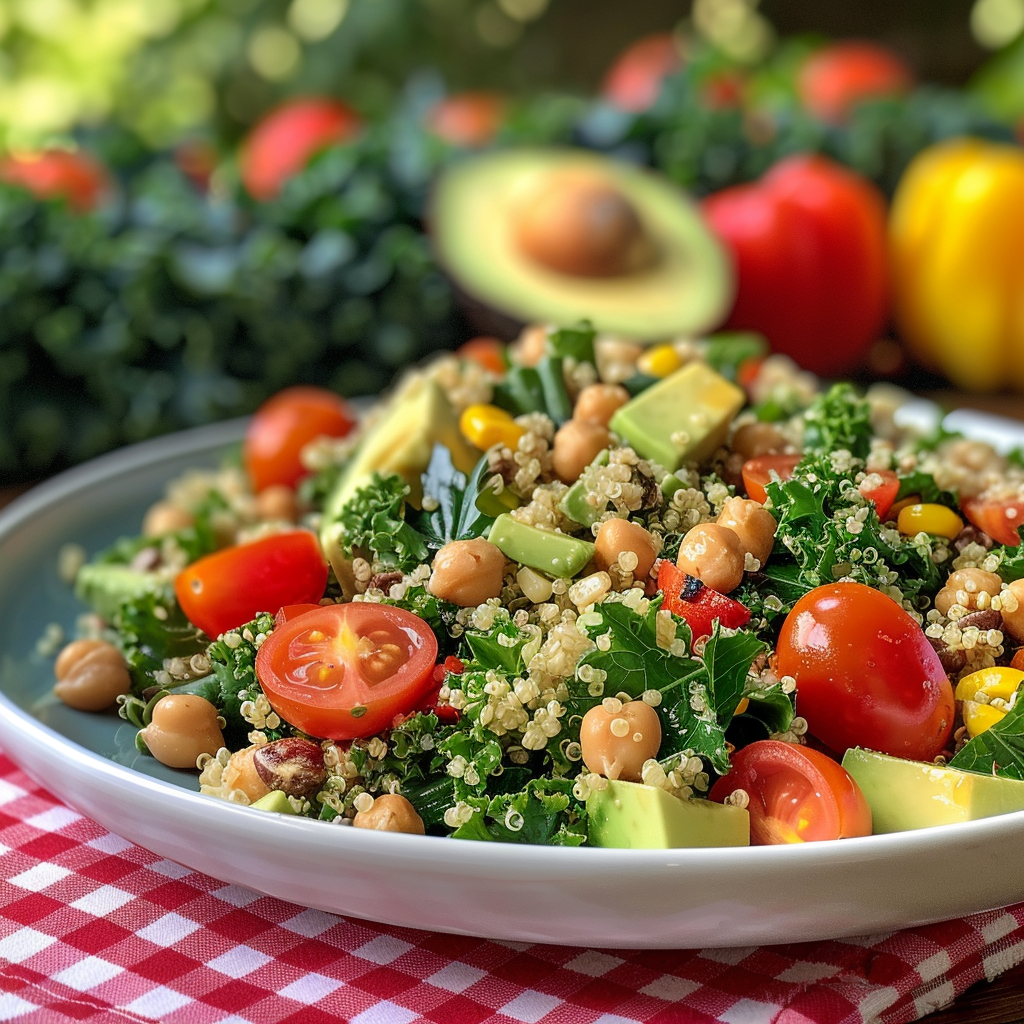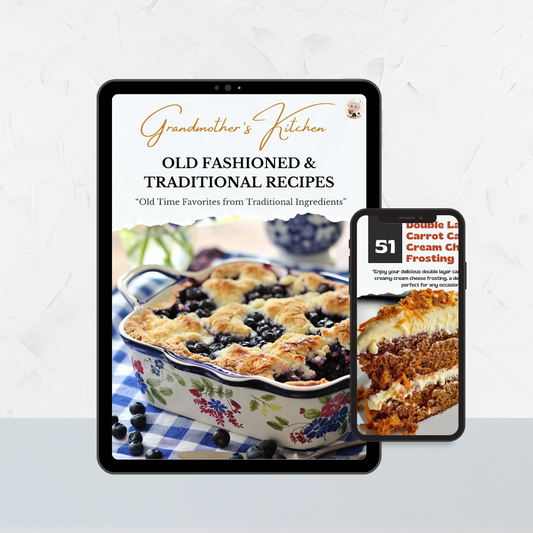Vegan Quinoa and Kale Salad with Lemon-Tahini Dressing – A Hearty, Nutritious Meal

Share
Vegan Quinoa and Kale Salad Is a Delightfully Hearty Set of Flavors
This Vegan Quinoa and Kale Salad is one of those dishes that can serve as both a refreshing lunch and a light dinner. The vibrant colors from the kale, quinoa, and fresh vegetables make it as beautiful as it is satisfying. What I love most about this salad is the combination of textures. The kale, softened with a quick massage in lemon juice, retains its heartiness, while the quinoa adds a lovely fluffiness. Then, there are the roasted chickpeas, offering a nice crunch that complements the creamy avocado. It's one of those salads that feels indulgent, yet it's packed with good-for-you ingredients. Plus, it's a perfect option for sharing at a gathering, knowing everyone—vegans, vegetarians, and omnivores alike—will enjoy it.
Did You Know?
Quinoa, often called a superfood, is packed with protein and all nine essential amino acids, making it one of the most complete plant-based protein sources. It’s also high in fiber, magnesium, iron, and antioxidants. A versatile grain, quinoa can be used in everything from salads to breakfast bowls, providing a nutritious base for a variety of meals. Because it’s naturally gluten-free, it’s a great option for those with dietary restrictions. The protein content, combined with the fiber in kale, makes this salad a powerhouse of nutrition.
Yield:
4 servings
Ingredients
1 cup quinoa
2 cups water
1 bunch kale, stems removed and leaves chopped
1 tablespoon lemon juice
1 cup red and yellow cherry tomatoes, halved
1 avocado, diced
1 cup roasted chickpeas
For the Lemon-Tahini Dressing:
1/4 cup tahini
2 tablespoons lemon juice
1 tablespoon maple syrup
1 clove garlic, minced
3-4 tablespoons water (to thin)
Salt and pepper to taste
Instructions
Prepare the Quinoa:
Rinse the quinoa under cold water. In a medium saucepan, combine the quinoa and water. Bring to a boil, then reduce the heat to low, cover, and simmer for 15 minutes or until the quinoa is tender and the water is absorbed. Fluff with a fork and let cool.
Personal Tip: Let the quinoa cool slightly before adding to the salad so it doesn’t wilt the kale.
Prepare the Kale:
In a large bowl, massage the chopped kale with the lemon juice for about 2-3 minutes until the leaves are softened.
Personal Tip: Massaging kale helps reduce its bitterness and makes it more palatable in salads.
Prepare the Dressing:
In a small bowl, whisk together the tahini, lemon juice, maple syrup, minced garlic, and enough water to reach your desired consistency. Season with salt and pepper to taste.
Personal Tip: Start with 3 tablespoons of water and add more if you prefer a thinner dressing.
Assemble the Salad:
In the large bowl with the kale, add the cooked quinoa, cherry tomatoes, avocado, and roasted chickpeas.
Personal Tip: Add the avocado last to avoid mashing it while mixing the salad.
Drizzle the lemon-tahini dressing over the salad and toss to combine.
Personal Tip: You can drizzle extra dressing on top just before serving for added flavor.
Serve:
Serve immediately or refrigerate for up to 2 days.
Personal Tip: If refrigerating, wait to add the avocado until just before serving to keep it fresh.
Nutritional Information (Per Serving):
Calories: 350, Fat: 18g, Saturated Fat: 2.5g, Carbohydrates: 38g, Fiber: 9g, Sugars: 6g, Protein: 12g
Kitchen Tips, Great Ideas, How to Save Money
- Bulk Buying: Purchase quinoa and roasted chickpeas in bulk. These ingredients are versatile and can be used in various recipes, reducing the cost per unit and saving you money in the long run.
- Homemade Roasted Chickpeas: If store-bought roasted chickpeas are expensive, consider making your own by roasting canned chickpeas in the oven with a drizzle of olive oil and your favorite spices. This can be more cost-effective and allows you to control the flavor and ingredients.
- Reusable Storage Containers: Invest in reusable storage containers for your salads. These containers are not only environmentally friendly but also save money over time compared to disposable options.
- Energy Efficiency: Cook quinoa in large batches and store it in the refrigerator for up to 5 days. This saves on energy costs and makes meal prep more efficient.
- Smart Storage: Store any leftover salad in an airtight container in the refrigerator. It will stay fresh for up to 2 days, providing a convenient and healthy meal throughout the week.
- Ingredient Substitutions: If avocado is unavailable or too expensive, you can use diced cucumber or bell pepper for a similar texture and flavor.
- Flavor Enhancements: Experiment with adding different flavors to your salad, such as a sprinkle of nutritional yeast for a cheesy flavor or a handful of fresh herbs like cilantro or parsley for added freshness.
- DIY Lemon-Tahini Dressing: Make your own lemon-tahini dressing in larger batches and store it in the refrigerator for up to a week. This dressing is versatile and can be used on other salads, roasted vegetables, or as a dip.
- Learning and Sharing: Join online vegan cooking communities for more recipe ideas and tips. Sharing your own experiences can also help others and foster a sense of community.
- Creative Presentations: Enhance the visual appeal of your salad by arranging the ingredients in a colorful and artistic manner. These additions not only add flavor but also create a beautiful presentation for your meal.
Let’s Learn About Kale
Kale comes in several varieties, the most common being curly kale, lacinato kale (also called dinosaur kale), and red Russian kale. Each type offers unique flavor and texture, with curly kale being slightly more bitter, while lacinato kale is tender and sweet. Most kale sold in stores is conventionally grown, which means it’s often treated with pesticides. If you're concerned about pesticide use, look for organic kale, or make sure to wash it thoroughly before eating. Kale is generally harvested by cutting the mature leaves from the plant, allowing the smaller leaves to continue growing. It’s highly nutritious, rich in vitamins A, C, and K, and offers a good source of fiber, calcium, and antioxidants. When buying kale, look for leaves that are firm and deeply colored with no yellowing, which can indicate age.


